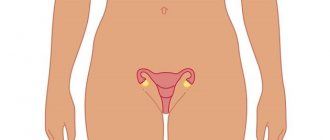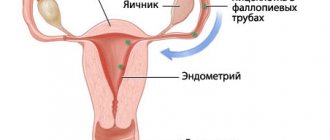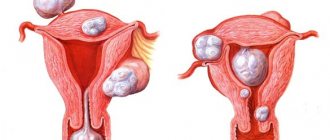Having made sure of her “interesting situation”, the expectant mother tries to calculate the expected date of birth (ED) using the last menstrual period or any other method. This is not surprising, because upcoming motherhood is the most exciting period in the life of every representative of the fairer sex. And correctly determining the date of delivery will allow you not to miss the onset of contractions and come to the maternity hospital fully armed. By looking at the menstrual cycle calendar and taking the first day of the last critical days as a starting point, you can determine the date of delivery no better than an obstetrician-gynecologist.
Calendar for determining the duration of pregnancy based on the last menstruation.
Childbirth is approaching: symptoms and possible signs
How to find out if you're due soon? How can you understand that certain symptoms are signs of impending labor? We are talking about a normally developing pregnancy, when at 37–42 weeks a full-term baby is ready to be born. At this time, the onset of labor pains is possible at any time, and this process is not always accompanied by certain and diagnostically accurate signs.
From a physiological point of view, the imminent onset of labor is indicated by a change in the hormonal levels of the pregnant woman. If in the previous months the level of progesterone, a hormone that supports the normal course of pregnancy, was higher than other indicators, then closer to childbirth its amount decreases, and the amount of other hormones of the female body, especially estrogens, increases. Their role in the functioning of a woman’s body throughout her life is enormous, and as “birth hormones,” estrogens play one of the leading roles. By the time of childbirth, the cervix should soften, become elastic, distensible, in order to ensure the passage of the child through the birth canal and not delay the processes of its birth and the birth of the placenta. In addition, as soon as the level of estrogen reaches a certain value, a signal is triggered for the body that the labor process can begin, contractions and, later, pushing begin.
Before the onset of labor, biologically active substances are also included in the work: prostaglandins, histamine, hormones oxytocin, serotonin and others. Their complex combined influence triggers the processes of uterine contraction, labor itself.
But can a woman somehow feel that childbirth is near? What signals does the body give about its readiness for them? Indeed, there are so-called “birth harbingers”, and with varying degrees of probability they can indicate that a successful end to pregnancy is close.
It is necessary, however, to remember that every woman’s body is individual. The time of appearance of such signs is very variable: in some, especially in primiparous women, they are noticeable 2-3 weeks before the expected event, in others literally the day before.
Online pregnancy calculator
For those who are no strangers to progress, automatic calculators have been developed that calculate pregnancy dates online. These can be special sites, or applications on the phone or programs on the computer. A woman enters her data into such a calculator and can receive information about pregnancy rates for her period. Or find out what medical procedures or tests she will have to undergo and take.
Why do you need a pregnancy calendar?
The pregnancy calendar shows how the baby has changed over time during pregnancy, how his body grows during certain periods, how he gains weight and other important developmental moments. The pregnancy calendar will give you the opportunity to understand what needs to be done, and what is better to refuse or what to limit yourself to at all stages of pregnancy.
A correctly calculated gestational age will help you calculate your gestational age.
The pregnancy calendar can also oversee the following points: which doctors are recommended to visit, what is best to eat, what medications to take (exclusively those that are taken without the recommendation of doctors) and what lifestyle in general to lead so that the child is healthy.
Using the pregnancy calendar, you can understand in what week an ultrasound will reveal the gender of the unborn child.
In addition, the calendar will help the expectant mother exchange useful information with friends who are in the same position throughout her pregnancy. Right now you can leave your comment and find out what other expectant mothers feel at a certain point in their pregnancy.
Gynecologists prefer to use this calendar in order to determine the age of the child and determine the main aspects of its development. But there is also the age of the fetus, which differs from the menstrual period of pregnancy by two weeks.
You need to know that the bodies of all pregnant women are different and the calendar cannot take into account the individual characteristics of a woman’s menstrual cycle, and therefore the calendar provides only general information for each. The dates are approximate because the length of the cycles themselves may differ for all women and vary from twenty-four to thirty-six days. It is also necessary to take into account that this cycle may be irregular.
Descent of the abdomen
Approximate period: from 36 weeks and later. In multiparous women, this can happen a day or two before giving birth. By the end of the gestation period, coordinated changes occur in the body of the child and the mother, the meaning of which is mutual preparation for the birth of the baby.
The baby takes a certain position - presentation and places the head or pelvis tightly above the future “exit” - the entrance to the pelvis. At this time, the uterus, which has grown significantly during pregnancy, descends, and after it the diaphragm descends. Now it does not put pressure on the higher organs - the stomach, lungs. The expectant mother will notice this - breathing will become easier, the stomach will not put pressure on the stomach: rhinitis during pregnancy will decrease, heartburn will go away. Perhaps you will want to go to the toilet a little more often: the prolapsed uterus has put pressure on the bladder.
Calculation based on last month
Those who want to calculate the PDR using the last menstrual period method just need to look at their cycle calendar and refresh their memory on the date when the last menstruation began. The ideal way to calculate the expected date of birth is the Naegele formula: subtract 3 months from the PDPM and add 7 days.
PLANETCALC, Determination of due date
The accuracy of the date calculation depends on the duration of the expectant mother's cycle.
If it is less than 25 days, birth may occur a couple of weeks earlier than the received date. If the cycle is more than 30 days, the baby’s appearance may be delayed by a week or two. In this case, the gestation is not considered post-term, because 280 days is the average length of pregnancy. However, it is impossible to “drive” all women into established criteria, so small discrepancies are more the norm than a deviation.
Training or false contractions
Approximate timing of appearance: from 30 to 39 weeks.
In medicine they are called Braxton-Higgs contractions. Some women experience them at the beginning of the seventh month of pregnancy, but most still feel them by the end of the eighth month. Many people are frightened by these sensations and mistake them for premature onset of labor. But this is a subjective feeling. And to understand whether these are really training contractions, it is enough to count the intervals between spasms. Such contractions occur at irregular intervals: between the first two or three, the interval may be 10-15 minutes, and the next contraction will come in 25 minutes or half an hour.
But the true ones come at regular intervals, which is easy to detect with a watch. In addition, the symptoms during real contractions, during normal labor, do not stop, their strength and frequency increase. And Braxton-Higgs contractions end after 2-3 hours, without ever entering a uniform repetition rhythm.
However, if such contractions begin in the last days, then they may well turn into real ones. And this is also easy to determine by the clock, when uneven intervals suddenly become ordered.
If you have doubts about the type of contractions, it is better to consult a doctor. And the doctor will also tell you how to help with false contractions.
| FALSE CONTRACTS | TRUE CONTRACTIONS |
| They do not become longer, stronger or more frequent over time. The intervals between them are irregular. | Their rhythm is regular, they increase in strength, frequency and duration. |
| They may not cause pain, but manifest themselves in the form of a pulling but weak sensation, similar to menstrual sensations. The uterus becomes hard, like an elastic ball. | The sensations increase in strength, severe aching pain in the lower back may appear, as well as an unpleasant feeling of fullness in the lower abdomen. |
| Stop or weaken if you lie down, walk or stand in the shower. | They do not change or disappear if you change your body position. |
| You can fall asleep with them | You won't be able to sleep with them |
| When examined, the cervix may be slightly dilated, but this does not change over time. | Examination of the cervix shows its softening and gradual opening. |
| Usually not accompanied by bleeding. In rare cases, brownish mucus may appear. | They may be accompanied by bloody discharge in the form of mucus - this is a mucus plug coming out. |
Ultrasonography
Ultrasound is one of the most well-known and frequently used methods for diagnosing embryo development. The most accurate way to find out the gestational age is through studies that are carried out at the earliest stage of pregnancy - up to 8 weeks.
The development of healthy embryos during this period proceeds identically and the gestation period is determined by their size, up to a day. Then children can show their own individuality; any healthy fetus may have some deviations from the given standards (larger limbs, slightly taller than normal, etc.).
In the case when this difference falls within a period of no more than 7-10 days, then doctors usually do not pay close attention to this fact, but if it is more than two weeks, then a diagnosis of intrauterine developmental delay of the embryo is determined. In this case, expectant mothers are advised to adjust their lifestyle, balance their own diet, and reduce possible stress.
Unpleasant sensations and discomfort
Approximate time of appearance: 2-1.5 weeks before the onset of labor.
When there is very little time left before giving birth, many women begin to experience discomfort in the lower part of the body. The sacrum pulls and compresses, the lower abdomen seems swollen and heavy. This is the uterus preparing for childbirth and descending, the ligaments on which it is suspended gradually soften and stretch, and the child stands with his head towards the birth canal.
As a rule, these sensations are relatively well tolerated, but if it is very painful, it is better to unscheduled visit an obstetrician-gynecologist managing the pregnancy: self-medication with painkillers at such a time is unacceptable.
Mucus plug
Estimated departure time: 37 - 38 weeks.
The mucus plug begins to form at 6-8 weeks of pregnancy, and consists of secretions from the cervical canal, which, under the influence of hormones, thicken and become a real plug, blocking the passage of bacteria into the uterus to the fertilized egg. It appears as a dense jelly-like or slimy mass, clear to brown in color or with reddish streaks. In preparation for childbirth, the cervix becomes shorter and the plug is pushed out.
Its appearance does not always indicate the onset of labor, especially since the timing of its release is very variable: it can take from a couple of weeks to a couple of hours from its appearance to the start of the labor process. Often its release does not occur simultaneously, some comes out in advance, and some remains until the contractions. Many women note that this process is preceded by nagging pain in the lower abdomen.
The appearance of bloody discharge
Approximate timing of appearance: after 35 weeks.
A typical situation that provokes the appearance of blood smears is a visit and examination by a gynecologist, sex. This blood is not a sign of bleeding. It only means that the hormonal system has adjusted to the prenatal period, the cervix and vagina have become loose and filled with blood. Even casual and gentle pressure on the vaginal wall leads to the appearance of a few drops of blood - precisely from overcrowding. And if only a small “daub” appears, then it is not dangerous.
Dyspeptic disorders
Possible timing of manifestation: 37 - 42 weeks.
Towards the end of pregnancy, under the influence of many factors, including hormonal ones, the functioning of many organs adjacent to the uterus changes. The intestines begin to move more actively, its peristalsis becomes more frequent and stronger. This leads to a more frequent urge to defecate, and the stool becomes very soft or unformed.
Dilatation of the cervix may also be accompanied by the urge to vomit and nausea. But, despite the fact that such complaints are quite typical, they require a medical examination. Nausea and vomiting can be combined with other symptoms - hypertension, fainting, spots flashing before the eyes, which may indicate the development of a serious, critical complication of pregnancy.
How can you tell when labor is starting?
The harbingers appear and then subside, and things are steadily moving towards childbirth. What will tell a woman that it’s time to go to the maternity hospital, what signs indicate with greater or less certainty that everything will begin soon?
Physiologically occurring childbirth goes through three main stages, each of which is accompanied by certain processes. The first stage is the beginning of labor, a process when the cervix dilates and shortens, amniotic fluid breaks, and contractions begin. The second, the actual birth of the child, is called the period of exile. And childbirth ends with the birth of the placenta.
The beginning of the first period may be indicated by the breaking of water. To do this, the amniotic sac must open. This can happen spontaneously, and sometimes not just before the onset of labor, but a little earlier. This phenomenon requires medical supervision, because before contractions begin, the amniotic sac is needed: it not only protects the baby and the uterus, but is also part of the system that stimulates the process of delivery. Therefore, if there are signs of water leakage, a woman should consult a doctor or undergo a leakage test.
- There may be minor pain, ranging from mild discomfort to moderate cramping pain.
- the feeling of warm liquid in the perineum may indicate that leakage or overflow has begun.
Such symptoms during childbirth require observation: it is necessary to monitor the child’s vital activity, the quantity and quality of the fluid that is released. So, if the waters contain an excessive amount of whitish suspended matter, or if they have a greenish tint, then this may indicate the child’s suffering, including hypoxia.
A small amount of water does not always indicate the exact beginning of labor. But if the volume of discharge is significant - from 800 ml or more, then, most likely, contractions are about to begin.
Prediction of baby's gender
There is an opinion that a pregnancy calendar by week will help calculate the sex of the child. Unfortunately, this is a misconception. Gender can be predicted only by the date of conception. In doing so, one should be guided by the following principles:
- Having sexual intercourse two days before ovulation guarantees the birth of a girl. The sperm that are responsible for the birth of a boy die a day before the cell appears in the genital tract.
- On the day of ovulation and 12-24 hours later, conception will give birth to a boy. The sperm that causes the birth of a son are faster and reach the cell sooner than those responsible for the birth of a daughter.
The sex of the child can be predicted or determined by the date of conception; to do this, use our ovulation calculator. When
compiling a pregnancy calendar by week, you can calculate the sex using a similar principle if the dates of productive sexual intercourse are known. But often couples spend more than one act waiting for a happy moment, and therefore it is very difficult to find out exactly which of them led to fertilization. If you want to predict the gender of your future baby, you should set fertilization dates in advance, guided by the above principles.
Determination of ovulation
Of course, you also need to be able to accurately determine your cell release day. There are several ways to do this:
- Conducting home tests. They show a reaction to a surge of the LH hormone, which sharply increases significantly at the moment the bubble ruptures.
- Using a microscope. Looking at a smear of saliva, you can trace the change in the pattern of salts that form the fern leaf by the time the cell appears.
- Female discharge. Until the day of ovulation, practically no mucus comes out. The day before and during it, it is plentiful, thick and viscous, outwardly reminiscent of egg white.
- Pain in the ovary. Not all ladies feel it, but this is a clear sign of a rupture of the follicle wall. It may feel very minor. It’s worth listening to your body so you don’t miss it.
- Basal temperature. A graph is drawn up based on rectal temperature parameters. A decline followed by a peak indicates ovulation. Measurements are carried out strictly according to the rules to prevent failure.
- Ultrasound. The doctor will be able to reliably monitor the growth of the bubble and name the date of its rupture.
Ovulation can be determined using special tests that are sold in pharmacies.
The appearance of contractions
They begin gradually, gradually. These are rhythmically repeating, uncontrollable sensations of contraction and relaxation of the uterus. Their main difference from training contractions is their repetition at relatively equal intervals of time. There is always a pause between contractions, during which the woman does not experience pain or cramps. The contraction itself is felt as a rather painful contraction with tension in the abdominal wall (the stomach “turns to stone”). Their strength, severity and frequency gradually increase, pauses become shorter. At that time:
- I period: the cervix opens;
- II period: the child moves along the birth canal, from where it is expelled by pushing.
- III period: the placenta is born during contractions.
At the beginning of the first labor period, contractions last on average 10-15 seconds, and the breaks between them reach 20 minutes. As the cervix dilates, each contraction lengthens and the intervals between them shorten. Towards the end of the opening, contractions can occur every 2 minutes with the same short intervals.
The amniotic sac opens, the water comes out, and the contractions “release” a little. This dynamics suggests that the second stage of labor is approaching, by which time the woman should already be under the supervision of doctors.
The appearance of at least one of the signs indicating the onset of labor is a reason for referral to a specialized institution (maternity hospital, perinatal center or clinic).
Ovulation calculation
The follicle grows during the first phase of the menstrual cycle. On the 14th day, ovulation occurs: the egg, mature and ready for fertilization, leaves the burst “house” and goes into the fallopian tube. It is here that she meets the male genetic material (sperm). From the moment of ovulation, the gestational period lasts 280 days (10 months or 40 obstetric weeks). The first two “pre-ovulation” obstetric weeks from the first day of the last menstruation (LDM) are also added here.
Formula for determining the maximum allowance: PDPM + 14 days + 280 days.
Sperm remain viable for 72 hours. Therefore, the day of “fertile” sexual intercourse or possible conception is not taken as a starting point.











